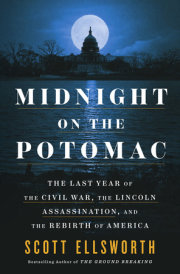Chapter 1
1921
Close your eyes and you can almost hear them.
It's a Thursday afternoon on a long-ago spring day. In the alleys and on the back porches it is still jacket weather. For even though the dogwoods and redbuds are in bloom, and bursts of sparrows explode out of the trees and bushes, in the shadows there's a lingering coolness in the air. Only they don't care. For today is the maids' day off and they've congregated, in twos and threes and fours, to stop and gossip along the sidewalks and storefronts. Gone are their uniforms, the long white aprons and striped dresses and peaked caps. Gone are the mops and the dust rags, the yes ma'ams and the no sirs, and the lye soap, starch, and bluing. In their place are smiles and laughter, felt hats and bobbed hair. Today is a day to exhale.
They aren't the only ones out and about. Up and down Greenwood Avenue, a small parade of humanity can be seen. There are ditchdiggers and shop owners, a mother with young children, an old man-born a slave-with ancient eyes and an ash-gray beard. Preachers and hustlers, doctors and dishwashers, a newspaper reporter, a uniformed messenger, and a deputy sheriff can all be found within a five-block radius. Some are getting off work, others are shopping. From a window up above drifts the sound of a Victrola. Maybe it's Mamie Smith, the Harlem singing sensation, belting out "Crazy Blues." Or maybe it's a rag or a Mozart piano sonata. In a second-floor office in the Williams Building, a dentist carefully sets a burr into his drill. Two doors down, an attorney inks one last contract for the day and hands it to his secretary.
Welcome to Greenwood. Spring, 1921.
We are in Tulsa's African American district, home to fourteen churches, two schools, a hospital, a post office substation, four hotels, two newspapers, and at least ten thousand residents, with the number swelling each week. A dozen physicians and surgeons live and work in Greenwood, as do lawyers, insurance agents, real estate salesmen, and pharmacists. In the shops you can buy dresses and three-piece suits, straw hats and bench-made shoes, pipe tobacco and household goods, tools and typewriter ribbon, perfume, eyeglasses, and bottles of patent medicine. There are ten tailors, four shoe repair shops, one filling station, and one feed store. Nor does the district lack opportunities for entertainment. The Dixie Theater seats more than a thousand, while the Dreamland has seating for 750. Both offer motion pictures, musical performances, lectures, and vaudeville acts. Nearby are pool halls and speakeasies.
This is no food desert. There are thirty-eight grocery stores, fruit and vegetable stands, and meat markets. Thirty restaurants serve everything from sandwiches and plate lunches to steaks and chops with all the trimmings. There's the Red Wing CafŽ and Kelley's Lunch Counter, the Waffle House and Doc's Beanery, as well a slew of double-named eateries-Bell & Little, Grace & Warren, Hardy & Hardy, Newman & Howard, White & Black, White & Brown, Wright & Davidson-where ditchdiggers and dentists, chauffeurs and custodians all sidle up to the counter and place their orders. Afterward, diners can pick up some smokes at the Oquawka Cigar Store, or a bag of sweets or some ice cream at Loula Williams's confectionery.
It is said that in Greenwood, a dollar bill will change hands a dozen times before it ever leaves the district. But equally important, its residents need not face the indignities heaped upon them at the white-owned shops downtown-the sighs and furrowed brows of the impatient white clerks, the ones who follow you down the aisles, then won't let you try on clothes beforehand. Here in Deep Greenwood, as the main commercial blocks are called, African American shoppers can purchase clothes at Black-owned stores, drop off their dry cleaning and laundry at Black-owned cleaners, and have their portraits taken in a Black-owned photography studio. Here, there are Black doctors and Black nurses, Black teachers and a Black principal, Black plumbers and Black house carpenters. Whites sneeringly call the district "Little Africa," or worse.
In Greenwood, there are African American men and women who own stores, hotels, and two- and three-story red brick office buildings. They pay property taxes, conduct business transactions with buyers and jobbers across the country, and live in newly built homes furnished with mahogany sideboards, cut-glass chandeliers, and carports. Their daughters take piano lessons and learn poise and elocution, while their sons dream of glory on the gridiron or baseball diamond. Women entrepreneurs are far from uncommon. Elizabeth Sawyer and Dora Wells operate their own dressmaking establishments. Other women manage real estate and run their own restaurants and shops.
Armed with grit, gumption, business acumen, hard work, and sometimes a bit of luck, the leading Black merchants of Tulsa have flourished. They read the Bible, newspapers, and novels, go to church on Sunday, and dress for dinner. The white bankers downtown know who they are, as do the shipping clerks and freight agents at the railway terminals. And while the overwhelming majority of African Americans in Tulsa live far more modestly, in rented rooms and shacks without running water, for those who have pulled ahead, Greenwood is a wonder, a living and breathing Black edition of the American Dream.
But Greenwood is far more than just a land of fat wallets and bulging coin purses.
It is also a mindset, a bearing, a way of engaging with the world. In an age when people of color are constantly being told that they are lesser beings, here is a community who knows that they are just as good as anyone. Nationally known African American leaders, such as Dr. W. E. B. Du Bois of the National Association for the Advancement of Colored People, have visited Tulsa to see what all the fuss is about. Jazz bands from Kansas City and Chicago will regularly come to Greenwood to play the latest, genre-busting sounds of a music that is fast capturing the attention of the world. Ideas flourish here as well. In classrooms and living rooms, across shop counters and in columns in the Tulsa Star and the Oklahoma Sun, they take root and cross-pollinate, are weighed and debated. There are political clubs, reading circles, and missionary societies. Hemmed in by a white world that values only their labor, Greenwood is an outpost of vitality, achievement, and pride
The evidence is everywhere.
You can see it in the women who drape themselves in pearls and fur for a show at the Dreamland or the Dixie. It's there, as well, in the steely gaze and set jaws of the neighborhood's World War veterans, who gather for reunions on Armistice Day. You can sense it in the comportment of the women and men who run their own businesses. And you can feel it in the presence of independent craftsmen who never, ever have to approach a white man with their hats in their hands. But it is there, as well, in those who take in laundry and scrub floors and wash dishes. For there is a frontier mindset here, an ironclad self-confidence and a can-do spirit. Greenwood isn't a gift from anyone. It is something they have built. It is their own.
By five o'clock, most of the merchants are closing up for the day and locking their doors. The maids are long gone, while the last of the shoppers make their final purchases and start to head home. As the shadows lengthen and wheel across Greenwood Avenue, and the afternoon sun glances off the top floor of the Stradford Hotel, there is once again a slight chill in the air. And while they do not know it yet, the people of Greenwood are on a collision course with the unimaginable.
Memorial Day, Monday, May 30, 1921.
An African American teenager walks along a downtown sidewalk. His name is Dick Rowland. Nineteen years old, a former football player at Booker T. Washington High School, he lives with his mother, Damie, in Greenwood, but works during the day in a white-owned and patronized shoeshine parlor located downtown on Main Street. When done correctly, a proper shoeshine takes more skill than meets the eye. Seated on a short-legged wooden stool in front of the thronelike chairs where the customers sit, Rowland will use a stiff horsehair brush and a soft rag to remove any caked-on dirt and grime. Then, with a cotton ball stuck on the end of a twisted length of wire, he will daub edge dressing, ink-black and smelling of alcohol, along the outer edges of the sole and heel. As that dries, he will dip a second rag into a tin of shoe paste and expertly apply it to the uppers, paying special attention to the cracks and creases of well-worn brogans and cap-toe oxfords, and to the delicate drilled patterns on the collars and facings of wing tips. Then he will buff and polish each pair to a glimmering shine.
There are no toilet facilities in the shine parlor for Dick Rowland and the other African American bootblacks. So the white owner has arranged for his employees to use the "Colored" restroom on the top floor of the Drexel Building, a block away on Main Street. This is where Rowland is headed now. To get to the washroom, he must ride the elevator located in the back of the building. The elevator is operated by Sarah Page, a white seventeen-year-old who, it is said, is saving her money to attend night school. At the very least, Sarah knows Dick and all the other shoeshiners by sight, as she carries them up to the fourth floor and back down again practically every day.
Only today is not like all the others.
Shortly after Dick enters the Drexel Building, Sarah screams.
And Dick is seen running away.
The police are summoned. Two detectives arrive and speak with Sarah. But they do not appear to be overly concerned. No all-points bulletin is issued, no squads of armed officers are dispatched on a manhunt. For whatever happened or did not happen in the elevator, Sarah Page will not press any charges. A white clerk in RenbergÕs, a high-quality clothing store located on the ground floor of the Drexel Building, however, is convinced that he knows just as plain as day what occurred between Rowland and Page. And while he did not actually witness anything, he talks to anyone who will listen.
The next morning, police officers arrive at Damie Rowland's home in Greenwood.
They don't stay long.
Dick Rowland is arrested and is taken downtown. He's booked at police headquarters and then, pending arraignment, is locked inside a jail cell located on the top floor of the county courthouse.
By late afternoon, there is lynch talk on the streets of white Tulsa.
But in Greenwood, there is talk of a different kind. At the Dreamland Theatre, an angry veteran jumps up onstage. "We're not going to let this happen," he shouts. "We're going to go downtown and stop this lynching. Close this place down."
Tuesday evening, May 31, around 7:00.
By now, more than three hundred white men, women, and children are gathered outside the Tulsa County Court House, a handsome Greek revival edifice located at Sixth Street and Boulder Avenue, along the southern edge of downtown. In the soft spring twilight, with the sky slowly turning pink and gold, they pack the nearby sidewalks and have spilled out into the streets. The women are wearing straw hats and light summer dresses, the men in overalls, suits, or dress shirts and ties. Groups of twos and threes and fours are talking and smoking, some sitting on the grass in the front yards of nearby houses. The mood is light and celebratory, with mockingbirds and chickadees chattering in the nearby oaks and elms. But the crowd is also determined, and expecting action.
Only nine months earlier, a large crowd of whites had gathered on these same streets and sidewalks. They had come to demand the release, into their custody, of a white eighteen-year-old former telephone company worker named Roy Belton, who had been charged with the cold-blooded murder of a white Tulsa taxicab driver. Belton had been arrested and was being held in a jail cell on the top floor of the courthouse when the crowd gathered and pressed its demand. At first, the sheriff refused. "Let the law take its course," he said. "The electric chair will get him before long." But it was all a show. When a handful of armed men wearing masks appeared at the courthouse door, the sheriff willingly handed over his prisoner. "We got him, boys! We got him!" the men shouted as they led Belton out of the courthouse. Within a half hour, Roy Belton was lynched a few miles outside town. Tulsa police officers directed traffic.
"It is my honest opinion," the police chief was quoted a couple of days later, "that the lynching of Belton will prove of real benefit to Tulsa." The sheriff agreed, stating that "it shows to the criminal that the men of Tulsa mean business." So did the Tulsa World, the city's morning newspaper. "There was not a vestige of the mob spirit in the act of Saturday night," it argued. "It was citizenship, outraged by government inefficiency and a too tender regard for the professional criminal."
Now, one year later, they have come for Dick Rowland.
Copyright © 2021 by Scott Ellsworth. All rights reserved. No part of this excerpt may be reproduced or reprinted without permission in writing from the publisher.











